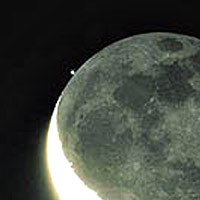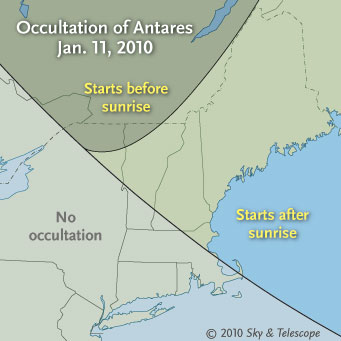Few celestial events are as dramatic as occultations, when the Moon (or another body) passes in front of a bright star or planet. Everything else in the sky happens on a time scale of minutes (for Jupiter's moons) to hours to millennia. But occultations of stars — aside from our own Sun — are almost instantaneous.

Spica (upper left) grazes the Moon's north polar region.
Four first-magnitude stars experience occultations by the Moon: Aldebaran, Antares, Regulus, and Spica. Antares is my favorite of those, for several reasons. It's the most colorful of the four, and it's set among several other bright stars. It has one of the biggest angular diameters of any stars — 0.045" — so it actually takes about 1/10th of a second to disappear — long enough to be perceptible, at least in theory. And it's a double star whose very faint companion was actually discovered during an occultation, shining briefly next to the Moon's limb after the bright star had disappeared.
If its orbit were fixed in space, then the Moon would occult the same stars each month. But in fact, the Moon's orbit wobbles like a top, with a period just under 19 years. So stars undergo long series of monthly occultations, followed by long periods with no occulations.

Tony Flanders
On January 11, 2010, Antares experiences the last occultation of the current series that's practical to observe from any populated place on Earth. This one won't be easy, either, but it should be visible through a telescope if the atmospheric conditions are good.
The good news is that the occultation is visible over a densely populated area, including the northeastern half of New England, a bit of New York and Ontario, and essentially all of Quebec and the Maritime Provinces. The bad news is that the sky will be extremely bright — far too bright to see Antares without a telescope. In the best locations (northern New York and Vermont, Montreal, Ottawa), the occultation starts a few minutes before sunrise. Over most of the area, it starts after the Sun has cleared the horizon.
In either case, the thing to do is to set up your telescope at least a half hour before sunrise, when Antares is still easy to see. Then you can keep tabs on the star's position as the Moon creeps up on it and the sky grows brighter.
For more information on observing occultations, see our online article Occultations: The Fastest Things in the Sky.
 2
2









Comments
joe tope
January 11, 2010 at 6:14 am
I live in north central Iowa so when I saw this morning's waning moon with a star so close to the western limb, I figured I missed an occultation. After checking this month's S and K, I see only the NE had an occultation. However, I wish I would have remembered this event, I would have witnessed a darn close, near grazing by the moon of (I agree with the author) the spectacular Antares. Got to go look again!
You must be logged in to post a comment.
rod
January 11, 2010 at 11:18 pm
From the Florida Keys, the near miss was a wonderful naked eye sight monday morning. Record cold for these parts added to the drama.
You must be logged in to post a comment.
You must be logged in to post a comment.